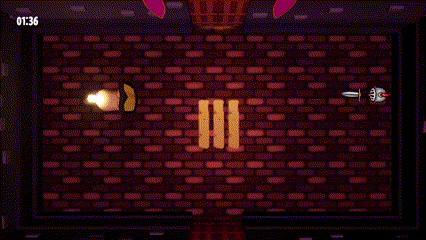
Nidhogg's Lair
Released December 2023
Nidhogg's Lair is a twin-stick action game, where every win will move you up in the dungeon and every loss, will send you back to the previous room.



UE 5
1
8 weeks

About
Nidhogg's Lair is a game where the player fights different enemies to progress, their goal is to get to the end and beat Nidhogg, the dungeon's boss.
Weapon
You are equipped with a sword that you can use to slash or throw at your enemies. Throwing may give you an edge, but you discard your weapon in the process.
Gamemode
The dungeon is a battle of tug of war against the enemies. Every time you clear a room, you push them forward and every time you die they push you back. The less time you take and the less times you die will determine your score at the end!
Enemies
Nidhogg is a serpent from Norse Mythology and he is the final boss of the game. To reach him, you must best his minions and learn their attacks to be able to clear the dungeon.

Role and Contribution
Game Designer
-
Create a proposal for the game based on research and concepting.
-
Design and implement a core gameplay loop, including core features: character and controls, a weapon, and a gamemode.
-
Concept and develop 2 simple enemies and a boss.
-
Playtest and iterate on all features to fit the intended player experience.
-
Balance enemy behavior in accordance with the gameplay.
-
Develop 2D and 3D visual assets.
Final Product
Goal
Your goal is to reach the final room in the dungeon and defeat Nidhogg. To do this, you must defeat different enemy encounters to increase your mastery at the game.
Player Experience
The game aims for a fast-paced, challenging, and methodical player experience. It forces the player to think on their feet and learn enemy attacks and patterns.
Nidhogg's Lair is easy to pick up and hard to master. The game features aim to be simple and intuitive, but the player has to learn and get better to progress and get higher scores.
Mastery
Core Gameplay Loop
The game's core gameplay loop consists of positioning, hitting enemies and dodging. It creates a fun and engaging loop that fits the game's theme and intention.

Original Proposal
Player


Character and Weapon
What
The character traverses by walking and dashing, it uses a sword to slash or throw it at enemies.
When thrown, the weapon is discarded and you are vulnerable until you pick it up. Vulnerability gives both player and enemies increased movement speed.
Why
The movement promotes the intended fast-paced and methodical player experience. The player must master the character to maneuver around the enemies, close the distance, and dodge their attacks.
The weapon attacks allow for a variety of play styles and promote the mastery pillar.
-
Close-ranged attacks deal more consistent damage faster on single targets with higher risk.
-
Long-ranged attacks provide big damage numbers but take time to charge, can be applied to many targets, and have a smaller risk.
-
The increased movement speed without the weapon helps the player recover the sword faster while the enemies pressure the player enhancing the feel of vulnerability. This creates a hunter vs hunted dynamic.
How
The character and weapon were based on a provided template, to suit the intended gameplay and game feel, I have playtested and iterated them, tweaking all variables and functionality.
Enemies
Nidhogg
What
Nidhogg is the boss waiting at the end of the dungeon.
-
It is aggressive towards the player and has shorter openings between attacks.
-
Each attack has a distinct feedforward.
-
Simple attacks:
-
The Tail Sweep: Nidhogg dashes towards the player and prepares for an attack. It sweeps its tail in a circle around it to execute the attack.
-
The Burrow: Nidhogg burrows into the ground and prepares an area of attack. It exits the ground to execute the attack.
-
-
Rare attacks:
-
The Roll Barrage: Nidhogg backs up to a wall and turns into a ball. It executes 3 rolls in a row in the direction of the player.
-
The Fireball: Nidhogg backs up to a wall. It executes 3 fireballs in a row that go to the last player's location.
-
Why
Nidhogg is the goal of the game which challenges the player's mastery. It makes the player feel uncertainty through its unpredictable and quick attacks. The player has to pay attention and react quickly to defeat the boss.
How
-
The attacks are split up into simple and rare. The enemy executes 2 simple attacks followed by a rare attack. The enemy always executes the simple attacks in a different order. The rare attacks are picked randomly. This gives the attacks a sense of unpredictability to them, but also a structure that makes the enemy feel polished.
-
These attacks are picked through a behavior tree system. They are constructed from smaller modular tasks (building blocks). There are short idle states between attacks to help blend Nidhogg's behaviors together.
Gamemode
Gamemode
Gamemode
The gamemode is a modified version of Tug of war.
-
When the player wins the encounter, they go to the next room. When the player dies they get sent back to the previous room and have to replay the previous encounter. The player only has 1 life per room.
-
When the player reaches the Nidhogg, the boss follows the player down if they die.
-
After beating Nidhogg, the player's score gets calculated based on the time it took them to beat the game multiplied by the room they finished in.
The gamemode ties the core gameplay loop with an outer loop that helps the player progress and get better at the game.
Design Intent
-
As the developer, I want the player to replay the same enemy encounters, to improve at the game before attempting the boss.
Progression
What
The gamemode is a modified version of Tug of war.
-
When the player wins the encounter, they go to the next room. When the player dies they get sent back to the previous room and have to replay the previous encounter. The player only has 1 life per room.
-
When the player reaches the Nidhogg, the boss follows the player down if they die.
-
After beating Nidhogg, the player's score gets calculated based on the time it took them to beat the game multiplied by the room they finished in.
The gamemode ties the core gameplay loop with an outer loop that helps the player progress and get better at the game.
Why
-
As the developer, I want the player to replay the same enemy encounters, to improve at the game before attempting the boss.
-
...
Iterative Process
Conclusion
Playtest
-
The game has been playtested 6 times with 3-4 testers per playtest. Both new and returning players have been used to test the game at different mastery levels.
-
Each playtest was prepared by stating a goal or reason, and questions.
-
Each playtest provided data by observing the players and by asking them the prepared questions.
-
A conclusion and action points were made based on the data.
Iteration
-
Iterations were made based on the conclusions and action points from the playtests by analyzing the problem and finding the best solution within our resources.
-
All major iterations were documented and further playtested to continue the iteration cycle.
Visuals
This project was a great learning experience for me and I am pretty satisfied with the work I did on it with the time and resources given. It helped me improve my general designer skills and develop my technical and AI toolset.
There were a few design challenges I faced, for a long time my players found the gamemode frustrating and the encounters up to the boss lacking in engagement. In the end, after constant iteration, I was able to turn it around and make the overall game enjoyable.
The game was well received by its players and had mostly good feedback. It is not perfect, but for a 8 week development process, it does a good job.

Basic Enemies
Shooter Enemy
Shooter enemies are squishy and try to shoot at the player from a distance, repositioning when necessary.
-
Their shooting feedforward is to show the bullet on top of their head. The bullet is big and slow so the player can easily follow its trajectory.
Why
-
They are used to onboard the player to the movement and the combat.
-
They do not pose a big threat, however in groups and in combinations with other enemy types they reinforce the challenging experience.
Shield Enemy
Shield enemies are tanky at the front and weak at the back.
-
They are slow and dash toward the player when they are far away.
-
They use melee attacks on the player when the player is close.
-
The best way of defeating them is to kite them into a dash or a melee attack and circle them.
Why
-
The shield enemies are used to help the player get better at their timing and movement by making the player go behind the enemy to kill it effectively reinforcing the methodical player experience.
Enemy Encounters
-
There are 5 short balanced encounters ranging in difficulty.
-
The player starts at the second encounter and the first one serves as a buffer for very new players.
Why
Each encounter helps achieve a certain level of mastery. They make sure the player learns at a steady pace at the same time achieving the fast-paced player experience.
How
-
The enemies are made via the UE behavior tree system, which includes tasks for moving toward the player, attacking, and idling. They pick between these behaviors based on values from decorators.
-
The enemy spawning and groups are determined by the level progression system.
2d and 3d Visual Assets
What
The following list of assets has been made for the game:
-
3D
-
Nidhogg's head, body, tail and rolling position
-
Shield
-
-
2D
-
Player head and sword
-
Enemy bullets and fireballs
-
Nidhogg's teeth, legs and mouth
-
Floor texture
-
-
Niagara VFX
-
Dashing particles used for both shield enemies and Nidhogg
-
Ground rumbling vfx
-
Death particles
-
Why
-
Visuals function as feedback on the player's and enemies' actions and their feedforward.
-
Lighting in the level emphasizes where the player is meant to go to progress, such as the lights behind the doors.
Progression
What
The game mode is a modified version of Tug of war.
-
The player has 1 life per room, when they win an encounter, they progress. When they lose, they replay the previous encounter. When fighting the boss, Nidhogg follows the player down.
-
The player's score is calculated based on the time and the room the player ends in.
Why
-
The gamemode is an elegant solution of displaying both health, progress, score multiplier, and the number of enemies in the room as a number on the floor.
How
-
The gamemode is implemented through the level progression system. It is a series of lined-up rooms that determine the player and camera location, enemy spawning, and the initial weapon state.


















